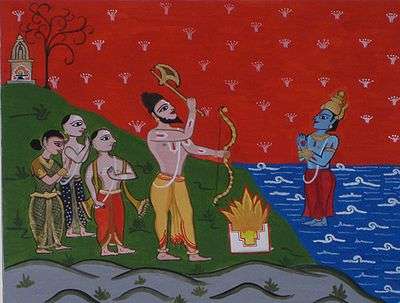Gaud Saraswat Brahmin
Gaud Saraswat Brahmins (also Goud or Gawd) are a Hindu Brahmin community in India and a part of the larger Saraswat Brahmin community. They belong to the Pancha (five) Gauda Brahmana groups. They are popularly referred to by the acronym GSB. They primarily speak Konkani as their mother tongue.

| Regions with significant populations | |
|---|---|
| Primary populations in Karnataka, Goa, Maharashtra and Kerala[1] | |
| Religion | |
| Hinduism | |
| Related ethnic groups | |
| Saraswat Brahmins |
History
According to the Sahyadrikhanda of the Skanda Purana, ninety-six Saraswat Brahmin families belonging to ten gotras migrated to Goa from the Saraswati river basin, along with Parashurama.[2][3] Reference to Saraswat names are found in Shilaharas as well as Kadamba copper plate inscriptions. The inscriptions found in Goa bear testimony to the arrival of Brahmin families in the Konkan region.[4]
The Shilahara kings seem to have invited supposedly pure Aryan Brahmins and Kshatriyas from the Indo-Gangetic plain to settle in Konkan. These castes are the Gaud Saraswat Brahmins and Chandraseniya Kayastha Prabhus.[5][6]
Sahyadrikhanda and Mangesh Mahatmya allude to migrations of Saraswat Brahmins, constituting ninety-six families, who settled in eight villages of Goa. There were regional variations among the Saraswats, such as those among Bardeskars, Pednekars and Sastikars. The Konkana mahatmya, from the 17th century CE, deals with the internal rivalry of the Saraswats and strained relations between these groups.In Kalhana's Rajatarangini (12th century CE), the Saraswats are mentioned as one of the five Pancha Gauda Brahmin communities residing to the north of the Vindhyas.[7]
The GSB ancestors identified themselves as of the Saraswat section of the northern Gaud division, in contrast to their Maharashtra and Karnataka Brahman neighbours of the southern division. Many Saraswats left Goa after the invasion of Malik Kafur to the neighbouring regions and during the period of religious persecution of the Portuguese also Saraswats migrated to Uttar Kannada, Dakshina Kannada, Kerala and North Konkan. The Saraswat Brahmins particularly served as administrators, village revenue collectors (Kulkarnis), financiers, landlords, priests, teachers and merchants in the intra-Asian trade, and diplomats. Many sources of government income in Goa, Konkan and elsewhere, including taxes on commodities and customs duties, remained in their hands.[4]
Diet and culture
The Saraswat Brahmins of the Konkan region eat fish as part of their diet.[8] Gaud Saraswats eat fish,[9][10][11] but Madhva Vaishnavite Gaud Saraswat Brahmins from coastal districts of Karnataka are vegetarians.[12][13]
Notable people
Festivals
See also
- List of Saraswats
- Canara Konkani
- Saraswat cuisine
- Rajapur Saraswat Brahmins
- Chitrapur Saraswat Brahmin
References
- Lola Nayar (1 October 2012). "The Konkan Rail". Outlook India. Retrieved 8 October 2016.
- Shree Scanda Puran (Sayadri Khandha) -Ed. Dr. Jarson D. Kunha, Marathi version Ed. By Gajanan shastri Gaytonde, published by Shree Katyani Publication, Mumbai
- Gomantak Prakruti ani Sanskruti Part-1, p. 206, B. D. Satoskar, Shubhada Publication
- Pinto, Celsa (1994). Trade and Finance in Portuguese India: A Study of the Portuguese Country Trade, 1770–1840 (Volume 5 of Xavier Centre of Historical Research Porvorim: XCHR studies series ed.). Concept Publishing Company. pp. 53–56. ISBN 9788170225072.
- Raj Pruthi, Rameshwari Devi (2004). Religions And Faiths In India. Mangal Deep Publications. p. 204. ISBN 8175941693.
There was a craze in the southern and eastern countries for the importation of the supposed pure Aryan Brahmins and Kshatriyas from the indo-gangetic valley in the north. The silhara kings of Konkan also seem to have invited both brahmins and kshatriyas from the north for settling in the south about this time.They are the Gauda Sarasvata Brahmins and the Chandraseniya Kayastha Prabhus of Konkan. The Gauda Sarasvata Brahmins and the Kayastha Prabhus are naturally often referred to as 'Aryas' which is corrupted to 'Aiyyas' in the inscriptions. The local Brahmins were referred to as 'Bhats', and the imported northerners as Aryas...
- Narayan Keshav Behere (1946). The Background of Maratha Renaissance in the 17th Century: Historical Survey of the Social, Religious and Political Movements of the Marathas. p. 81.
- D. Shyam Babu and Ravindra S. Khare, ed. (2011). Caste in Life: Experiencing Inequalities. Pearson Education India. p. 168. ISBN 9788131754399.
- Understanding Society: Readings in the Social Sciences. Macmillan International Higher Education. October 1970. p. 273. ISBN 9781349153923. Retrieved 4 March 2019.
- Kaw, M. K. (2001). Kashmiri Pandits: Looking to the Future. APH Publishing. ISBN 9788176482363. Retrieved 7 April 2019.
- "Gowd Saraswat Cuisine, Where Fish Dishes Hold a Special Place". NDTV Food. 16 June 2017. Retrieved 7 April 2019.
- "Forward castes must think forward as well". Hindustan Times. 23 November 2014. Retrieved 18 March 2019.
- S. Anees Siraj (2012). Karnataka State: Udupi District. Government of Karnataka, Karnataka Gazetteer Department. p. 189.
- The Illustrated Weekly of India, Volume 91, Part 2. Published for the proprietors, Bennett, Coleman & Company, Limited, at the Times of India Press. 1970. p. 63.
The Saraswats are largely a vegetarian community, whose coconut- based cuisine is famed for its variety.
Further reading
- Suryanath U Kamath (1992). The origin and spread of Gauda Saraswats.
- Venkataraya Narayan Kudva (1972). History of the Dakshinatya Saraswats. Samyukta Gauda Saraswata Sabha.
- Ramachandra Shyama Nayak. "Saraswath Sudha". Cite journal requires
|journal=(help) - Kawl, M. K. (2001). Kashmiri Pandits: Looking to the Future. ISBN 9788176482363.
- Bryant, Edwin (2001). The Quest for the Origins of Vedic Culture. Oxford University Press. ISBN 0-19-513777-9.
- Hock, Hans (1999) "Through a Glass Darkly: Modern "Racial" Interpretations vs. Textual and General Prehistoric Evidence on Arya and Dasa/Dasyu in Vedic Indo-Aryan Society." in Aryan and Non-Aryan in South Asia, ed. Bronkhorst & Deshpande, Ann Arbor.
- Shaffer, Jim G. (1995). "Cultural tradition and Palaeoethnicity in South Asian Archaeology". In George Erdosy (ed.). Indo-Aryans of Ancient South Asia. ISBN 3-11-014447-6.
- Conlon, Frank F. (1974). "Caste by Association: The Gauda Sarasvata Brahmana Unification Movement". The Journal of Asian Studies. 33 (3): 351–365. doi:10.2307/2052936. JSTOR 2052936.